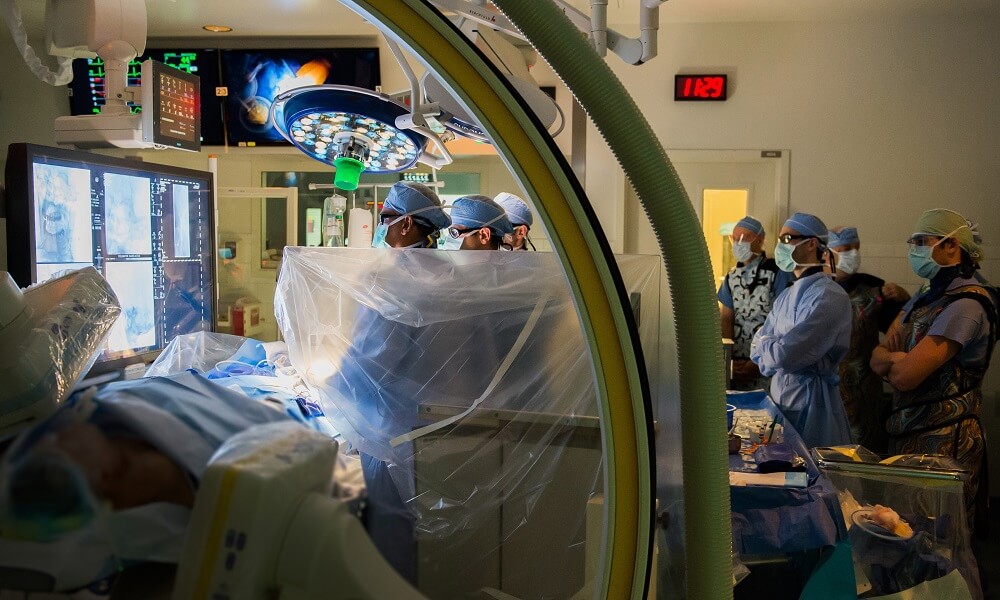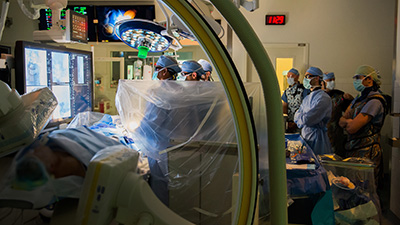Overview
The Massachusetts General Hospital Thoracic Aortic Center combines the expertise of a team of clinicians from multiple disciplines and many perspectives, including specialists in cardiac, vascular and endovascular surgery, cardiology, vascular medicine, cardiac and vascular intervention, imaging and anesthesia. Our specialists care for patients with conditions of the thoracic aorta, including acute and chronic aortic dissections, thoracic and thoracoabdominal aortic aneurysms, Marfan syndrome and coarctation of the aorta.
There is a collaborative environment in the Thoracic Aortic Center, resulting in a focused approach to a patient’s problem. While our sophisticated technologies may drive the treatment, it is the entire team of specialists who implements the plan. The composition of the team at the Thoracic Aortic Center builds and grows depending on each patient’s needs. Specialists begin with a thorough evaluation, which details the patient’s history of prior cardiovascular disease and hypertension as well as the history of the aortic condition itself. Patients bring any previous studies with them and, when necessary, we order additional tests.
Once we have excellent definition of the relevant anatomy, our cardiologists, vascular medicine specialists, and cardiac and vascular/endovascular surgeons collaborate in a discussion of the findings. By carefully studying the results of imaging studies and considering the patient’s past medical history, the team weighs the risks and benefits of various treatments and recommends a course of optimal management to the patient, family and referring physician.
Depending on the patient’s needs, the team can add a whole host of support services, including interpreters, social workers and other medical specialists. All of this happens quickly, with the patient typically having a treatment plan established at the end of the first visit.
Conditions We Treat
Established in 1999, the Thoracic Aortic Center strives to provide the best-possible patient care, educate both patients and physicians about lifelong management of thoracic aortic disease and develop new treatment options. Treatment combines advanced resources and the specialized expertise of cardiologists, cardiac surgeons, vascular/endovascular surgeons and vascular radiologists. A collaborative approach to care allows our specialists to optimally manage conditions such as:
- Thoracic aortic aneurysms
- Thoracoabdominal aortic aneurysms
- Marfan syndrome
- Acute and chronic aortic dissection
- Intramural hematoma of the aorta
- Penetrating atherosclerotic ulcers of the aorta
- Coarctation of the aorta
- Aortitis
- Aortic transsection
Thoracic aortic diseases are unusual, complicated problems requiring complex solutions. The Thoracic Aortic Center offers the most advanced treatments available and is a complete, interdisciplinary resource for patients with the full spectrum of thoracic aortic disease. This program's approach streamlines the care of patients with complex aortic disease so that they receive input from multiple specialists.
Multidisciplinary Care
This multidisciplinary approach enhances the quality of care by fostering close communication with everyone involved in the patient’s treatment. Visits are coordinated such that patients have any necessary testing and visits with one or more appropriate physicians on the same day, and team members can consult with one another at any time. Team conferences and electronic medical records facilitate collaboration among specialists, resulting in well-integrated, consistent treatment approaches that promise the best outcomes possible.
The attending physician is the leader of the team. Patients and their families are encouraged to be partners with us on the treatment team and to be involved in every decision along the way. In order for patients to make informed decisions, education is a cornerstone of our care.
Diagnosing Thoracic Aortic Disease
To accurately diagnose aortic disease, our team includes attending staff radiologists who are specially trained in the evaluation of the cardiovascular system and whose practice focuses specifically on vascular disease. These imaging specialists are board certified in general radiology and fellowship trained with additional specialization in cardiac and vascular procedures.
The initial medical evaluation of a patient includes:
- A general cardiac assessment
- Determination of whether or not intervention is necessary
- If intervention is necessary, determining which procedure is most appropriate for the patient’s specific condition
Imaging Techniques
Our specialists may use one or more imaging techniques to fully reveal the aortic anatomy, including:
- CT scans (computed tomography)
- MRI (magnetic resonance imaging)
- MRA (magnetic resonance angiography)
- Contrast angiography
- Transesophageal echocardiography (TEE)
Innovative Treatment Strategies
In addition to standard therapies, specialists offer a number of innovative strategies for managing thoracic aortic diseases, including:
Surgical repair of thoracic aortic aneurysms is usually carried out when the aneurysm is large enough in size to carry a significant risk of rupture or dissection, or when aneurysms cause symptoms. Aneurysms of smaller size are usually managed medically with blood pressure control and periodic follow-up imaging.
Leading-Edge Treatments for Abdominal Aortic Disease
Our main goal is to evaluate patients and design a personalized treatment plan that decreases the risk of aneurysm rupture. Treatment is determined according to the severity and size of a patient’s abdominal aortic aneurysm and includes:
- Medical therapy: Medications used to manage abdominal aortic disease include drugs to control cholesterol and blood pressure
- Endovascular stent graft repair: This minimally invasive procedure involves the placement of a covered stent to reline the aneurysm and to keep it from bursting. Stent graft repair is less invasive than open surgery and often results in faster recovery times
- Open surgical aneurysm repair: During this procedure, an aortic graft (a durable tube) is sewn in place to replace the weakened segment of artery and keep it from bursting
Access to Promising New Treatments
The Thoracic Aortic Center participates in major clinical studies evaluating new technologies and devices to treat abdominal and thoracic aortic disease. This allows us to bring our patients promising new treatments as quickly as possible. Some of these studies include:
- New devices: Physicians at the Thoracic Aortic Center are currently investigating new devices for the minimally invasive treatment of aortic disease, including endovascular stent grafts for thoracic aortic aneurysms and devices that may prevent stent grafts from moving
- Fenestrated stent grafts: This investigational approach is being studied for its potential to extend endovascular stent graft technology to patients with more complicated abdominal aortic aneurysms
- IRAD: Mass General is one of 24 large referral centers participating in the International Registry of Aortic Dissection (IRAD), a leading consortium of research centers that evaluate the management and outcomes of acute aortic dissection
- Protecting the spine: Physicians from the Thoracic Aortic Center are refining new cerebral and spinal protection techniques that significantly reduce the risk of stroke and paralysis during procedures
Patients interested in participating in clinical trials should contact their provider for more information
View a sample of our clinical research here >
Lifelong Care for Thoracic Aortic Disease
Patients with aortic disease who are diagnosed and managed appropriately can expect to lead relatively normal lives, but lifelong management of the disease is required. Patients need to have control of their blood pressure over their lifetimes in order to avoid hypertension (high blood pressure) and limit the stress on the weakened wall of the aorta. In order to optimally monitor blood pressure, we typically recommend that patients buy an automatic blood pressure cuff to use at home on a regular basis.
Patients are given recommended target blood pressure readings and encouraged to contact their Thoracic Aortic Center doctor if their blood pressure drifts out of range. Patients also undergo periodic imaging studies to look for changes in the size of the involved portions for the aorta. Most of the time the imaging studies are either a special type of contrast-enhanced CT scan known as CT angiogram (or CTA) or a gadolinium-enhanced MRI known as an MR angiogram (or MRA).
The Thoracic Aortic Center follows patients after initial diagnosis and treatment to ensure that the patients and their doctors are doing everything possible to manage their aortic disease. The Thoracic Aortic Center also ensures that primary doctors are kept informed every step of the way.
Referrals
Patient referrals can be made to the Thoracic Aortic Center at 866-644-8910 or directly to any of the participating physicians. Coverage is available 24 hours per day, seven days per week to receive emergency referrals from any regional physician or emergency department if an acute syndrome related to the thoracic aorta is suspected. A phone call to the Thoracic Aortic Center will set in motion the assembly of a team for emergency evaluation and management of the patient. Outpatient referrals of patients with thoracic aortic aneurysms will result in multidisciplinary evaluation by appropriate physicians from cardiology, vascular radiology, cardiac and vascular surgery. Patients can be seen by multiple physicians on the same day, and the appointments are made with a single phone call to the Thoracic Aortic Center number. Evaluation will result in a recommendation for either intervention or follow-up. Follow-up for the aortic problem will be arranged at the Center. General cardiac and pulmonary evaluation may also be done.




